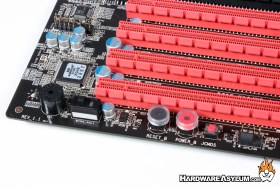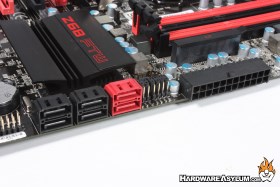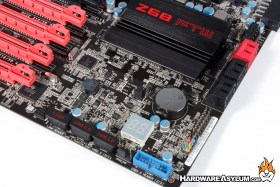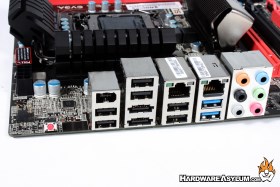EVGA Z68 FTW Motherboard Review
Author: Dennis Garcia
Published: Thursday, October 27, 2011
Board Layout and Features Cont.
Dual channel memory comes standard on the Sandy Bridge and the Z68 FTW supports DDR3 modules up to 2133Mhz with a maximum of 16GB usable. 24pin ATX power is located in the traditional location near the upper edge of the motherboard and is oriented 90 degrees to help with cable routing and airflow.
Some people may take issue with this since the power leads are now exposed. While we can agree that exposed wires are bad, the danger here isn't the exposed wires but rather folks using forks to work on their computers. Of course if you are worried about it, put a little electrical tape down and call it good.
Some people may take issue with this since the power leads are now exposed. While we can agree that exposed wires are bad, the danger here isn't the exposed wires but rather folks using forks to work on their computers. Of course if you are worried about it, put a little electrical tape down and call it good.

Around the memory slots you will find a single Compact Flash card reader and voltage test points across the top of the motherboard. Compact flash is a rather old interface but works quite well as a small hard drive replacement.
The benchtop buttons are located at the bottom of the motherboard under the last PCI Express slot and consist of the standard power reset and cmos buttons. To the left you will find a triple position slider switch that will allow you to manually select from any of the 3 BIOS chips.
The benchtop buttons are located at the bottom of the motherboard under the last PCI Express slot and consist of the standard power reset and cmos buttons. To the left you will find a triple position slider switch that will allow you to manually select from any of the 3 BIOS chips.
Internal SATA connections number six. The black connections are SATA3 spec while the red connections follow the new SATA6 connection standard direct from the Z68 chipset. Above the SATA connections you will find a series of jumpers which are how you can disable any of the PCI Express slots for debugging purposes. It also gives you a convenient way to run multi card benchmarks without having to tear everything down.
Front panel controls are located in the traditional location and consist of USB 2.0, 3.0, and Firewire connections. You'll find a debug LED located to the right of the onboard BIOS chips. There are three to choose from with one of them being removable incase of serious failure.
Front panel controls are located in the traditional location and consist of USB 2.0, 3.0, and Firewire connections. You'll find a debug LED located to the right of the onboard BIOS chips. There are three to choose from with one of them being removable incase of serious failure.
The I/O panel on the Z68 FTW board is extremely full, and yet empty. Starting at the top you'll find a lonely CMOS reset button followed by ten USB ports. Two follow the USB 3.0 standard while two others are combined with eSATA connections. Dual Gigabit Ethernet connections, Firewire and 8 channel analog audio finish out the I/O panel offerings.
Of course what you won't find on this motherboard is a PS/2 port for keyboard or mouse. While most overclockers will consider this the end-all of no-nos the CPU cycle hit during benchmark runs is minimal.
Our biggest complaint was simply the need to locate a USB keyboard just to use the motherboard.
Of course what you won't find on this motherboard is a PS/2 port for keyboard or mouse. While most overclockers will consider this the end-all of no-nos the CPU cycle hit during benchmark runs is minimal.
Our biggest complaint was simply the need to locate a USB keyboard just to use the motherboard.





